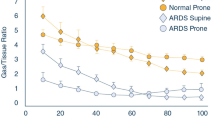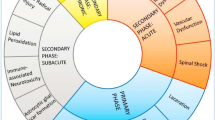Abstract
Purpose
It remains controversial how to immobilize the cervical spine (CS) in trauma patients. Therefore, we analyzed different CS immobilization techniques during prehospital patient transport.
Methods
In this explorative, biomechanical analysis of immobilization techniques conducted in a standardized setting, we recorded CS motion during patient transport using a wireless human motion tracker on a volunteer. To interpret spinal movement a benchmark called motionscore (MS) was developed based on biomechanics of the injured spine.
Results
We found the best spinal motion restriction using a spine board, head blocks and immobilization straps with and without a cervical collar (CC) (MS 45 vs. 27). Spinal motion restriction on a vacuum mattress with CC and head blocks was superior to no CC or head blocks (MS 103 vs. 152). An inclined vacuum mattress was more effective with head blocks than without (MS 124 vs. 187). Minimal immobilization with an ambulance cot, CC, pillow and tape was slightly superior to a vacuum mattress with CC and head blocks (MS 92 vs. 103). Minimal immobilization without CC showed the lowest spinal motion restriction (MS 517).
Conclusions
We suggest an immobilization procedure customized to the individual situation. A spine board should be used whenever spinal motion restriction is indicated and the utilization is possible. In some cases, CS immobilization by a vacuum mattress with CC and head blocks could be more beneficial. In an unstable status of the patient, minimal immobilization may be performed using an ambulance cot, pillow, CC and tape to minimize time on scene caused by immobilization.





Similar content being viewed by others
References
Sekhon LH, Fehlings MG. Epidemiology, demographics, and pathophysiology of acute spinal cord injury. Spine. 2001;26:S2–12.
Bernhard M, Gries A, Kremer P, Böttiger BW. Spinal cord injury (SCI)—prehospital management. Resuscitation. 2005;66:127–39.
Domeier RM, Evans RW, Swor RA, Rivera-Rivera EJ, Frederiksen SM. Prehospital clinical findings associated with spinal injury. Prehosp Emerg Care. 1997;1:11–5.
Theodore N, Hadley MN, Aarabi B, Dhall SS, Gelb DE, Hurlbert RJ, et al. Prehospital cervical spinal immobilization after trauma. Neurosurgery. 2013;72(Suppl 2):22–34.
Deutsche Gesellschaft für Unfallchirurgie (DGU) S3-Leitlinie Polytrauma/Schwerverletzten-Behandlung. 2016; AWMF-Register Nr. 012/019
National Clinical Guideline Centre (UK) (2016) Spinal injury: assessment and initial management. NICE Guideline, No. 41. London: National Institute for Health and Care Excellence (UK).
Davies G, Deakin C, Wilson A. The effect of a rigid collar on intracranial pressure. Injury. 1996;27:647–9.
Hunt K, Hallworth S, Smith M. The effects of rigid collar placement on intracranial and cerebral perfusion pressures. Anaesthesia. 2001;56:511–3.
Cordell WH, Hollingsworth JC, Olinger ML, Stroman SJ, Nelson DR. Pain and tissue-interface pressures during spine-board immobilization. Ann Emerg Med. 1995;26:31–6.
Swartz EE, Tucker WS, Nowak M, Roberto J, Hollingworth A, Decoster LC, et al. Prehospital cervical spine motion: immobilization versus spine motion restriction. Prehosp Emerg Care. 2018;22:630–6.
Ham W, Schoonhoven L, Schuurmans MJ, Leenen LPH. Pressure ulcers from spinal immobilization in trauma patients: a systematic review. J Trauma Acute Care Surg. 2014;76:1131–41.
Pernik MN, Seidel HH, Blalock RE, Burgess AR, Horodyski M, Rechtine GR, et al. Comparison of tissue-interface pressure in healthy subjects lying on two trauma splinting devices: The vacuum mattress splint and long spine board. Injury. 2016;47:1801–5.
Goutcher CM, Lochhead V. Reduction in mouth opening with semi-rigid cervical collars. Br J Anaesth. 2005;95:344–8.
Totten VY, Sugarman DB. Respiratory effects of spinal immobilization. Prehosp Emerg Care. 1999;3:347–52.
Liao S, Schneider NRE, Hüttlin P, Grützner PA, Weilbacher F, Matschke S, et al. Motion and dural sac compression in the upper cervical spine during the application of a cervical collar in case of unstable craniocervical junction-A study in two new cadaveric trauma models. PLoS One. 2018;13:e0195215.
Fischer PE, Perina DG, Delbridge TR, Fallat ME, Salomone JP, Dodd J, et al. Spinal motion restriction in the trauma patient—a joint position statement. Prehosp Emerg Care. 2018;22:659–61.
Kwan I, Bunn F, Roberts I. Spinal immobilisation for trauma patients. Cochrane Database Syst Rev. 2001;(2):CD002803.
Beisemann N, Noweski A, Kreinest M. Wirbelsäulenimmobilisation bei Patienten mit schwerem Schädel-Hirn-Trauma—Einfach, praktisch. Notfall Rettungsmed. 2018;21:402–5.
Kreinest M, Gliwitzky B, Schüler S, Grützner PA, Münzberg M. Development of a new Emergency Medicine Spinal Immobilization Protocol for trauma patients and a test of applicability by German emergency care providers. Scand J Trauma Resusc Emerg Med. 2016;24:71.
Rahmatalla S, DeShaw J, Stilley J, Denning G, Jennissen C. Comparing the efficacy of methods for immobilizing the cervical spine. Spine. 2019;44:32–40.
Mahshidfar B, Mofidi M, Yari A-R, Mehrsorosh S. Long backboard versus vacuum mattress splint to immobilize whole spine in trauma victims in the field: a randomized clinical trial. Prehosp Disaster Med. 2013;28:462–5.
Wampler DA, Pineda C, Polk J, Kidd E, Leboeuf D, Flores M, et al. The long spine board does not reduce lateral motion during transport–a randomized healthy volunteer crossover trial. Am J Emerg Med. 2016;34:717–21.
Johnson DR, Hauswald M, Stockhoff C. Comparison of a vacuum splint device to a rigid backboard for spinal immobilization. Am J Emerg Med. 1996;14:369–72.
Etier BE, Norte GE, Gleason MM, Richter DL, Pugh KF, Thomson KB, et al. A comparison of cervical spine motion after immobilization with a traditional spine board and full-body vacuum-mattress splint. Orthop J Sports Med. 2017;5:2325967117744757.
Luscombe MD, Williams JL. Comparison of a long spinal board and vacuum mattress for spinal immobilisation. Emerg Med J. 2003;20:476–8.
Prasarn ML, Hyldmo PK, Zdziarski LA, Loewy E, Dubose D, Horodyski M, et al. Comparison of the vacuum mattress versus the spine board alone for immobilization of the cervical spine injured patient: a biomechanical cadaveric study. Spine. 2017;42:E1398–E14021402.
Akkuş Ş, Çorbacıoğlu ŞK, Çevik Y, Akıncı E, Uzunosmanoğlu H. Effects of spinal immobilization at 20° on respiratory functions. Am J Emerg Med. 2016;34:1959–62.
Haut ER, Kalish BT, Efron DT, Haider AH, Stevens KA, Kieninger AN, et al. Spine immobilization in penetrating trauma: more harm than good? J Trauma. 2010;68(115):120–121.
Velopulos CG, Shihab HM, Lottenberg L, Feinman M, Raja A, Salomone J, et al. Prehospital spine immobilization/spinal motion restriction in penetrating trauma: a practice management guideline from the Eastern Association for the Surgery of Trauma (EAST). J Trauma Acute Care Surg. 2018;84:736–44.
Acknowledgements
The authors would like to thank all our participating staff. Furthermore, we thank the team from Fire and Rescue Training Centre (FRTC) of the Frankfurt fire department.
Funding
We gratefully acknowledge the funding of the BG Trauma Centre Ludwigshafen, the German Association of Emergency Medical Technicians (Deutscher Berufsverband Rettungsdienst e.V. DBRD) and the Friends Association of the Air Rescue Centre Frankfurt. The sponsors had no influence on the study design, data collection and analysis, decision to publish, or preparation of the manuscript.
Author information
Authors and Affiliations
Corresponding author
Ethics declarations
Conflict of interest
DH and DU are PHTLS instructors. The other authors declare that they have no conflict of interest.
Ethics approval
All procedures performed in this study involving human participants were in accordance with the ethical standards of the Ethics Committee of the State Medical Association of the Rhineland-Palatinate [ID 837.508.15 (10276)] and with the 1964 Helsinki declaration and its later amendments or comparable ethical standards. This article does not contain any studies with animals performed by any of the authors. The study is registered in the German Clinical Trials Register with the ID DRKS00009505.
Informed consent
Informed consent was obtained from all individual participants included in the study. Additional informed consent was obtained from all individual participants for whom identifying information is included in this article. Data collection, coding, routing and analysis were in accordance with legal data protection policy.
Rights and permissions
About this article
Cite this article
Nolte, P.C., Uzun, D.D., Häske, D. et al. Analysis of cervical spine immobilization during patient transport in emergency medical services. Eur J Trauma Emerg Surg 47, 719–726 (2021). https://doi.org/10.1007/s00068-019-01143-z
Received:
Accepted:
Published:
Issue Date:
DOI: https://doi.org/10.1007/s00068-019-01143-z




